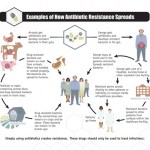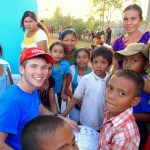infectious diseases
Ebola virus disease (EVD), formerly known as Ebola hemorrhagic fever, has been reported in humans since 1976, but the current epidemic of the disease – affecting Guinea, Liberia, and Sierra Leone – is unprecedented. There is no vaccine or cure for Ebola, and in past outbreaks up to 90% of people confirmed to have the disease died (the case-fatality rate is closer to 60% this time). A WHO fact sheet gives a grim list of the symptoms:
EVD is a severe acute viral illness often characterized by the sudden onset of fever, intense weakness, muscle pain, headache and sore throat. This is followed by…
It looks like a simple piece of paper and it’s nearly as cheap, ideally costing just pennies. But despite its small size, it’s poised to make an enormous impact and potentially save thousands of lives.
It’s a new test to spot counterfeit versions of the drug artesunate, which is one of the most important drugs used to treat malaria, a mosquito-borne disease that affects hundreds of millions of people every year. Based on the science of microfluidics, researchers at Oregon State University developed an easy-to-use and inexpensive testing kit that patients and health care providers can use to…
by Phyllis Freeman and Anthony Robbins, MD, MPA
One of our public health heroes, Ciro de Quadros, a public health physician from Brazil died on May 28, 2014. We need his attitude, skills, and persistence more than ever today. Ciro was a master of innovation, particularly in his efforts to prevent infectious diseases with vaccines. It seems especially timely today to review highlights of his career.
And why now? For one, because just now efforts to eliminate polio are foundering in the wake of the US CIA’s disastrous and hugely counterproductive scheme to identify Osama bin Laden’s…
Despite our best preparedness efforts, a real-life flu pandemic would require some difficult and uncomfortable decisions. And perhaps the most uncomfortable will be deciding who among us gets priority access to our limited health care resources. How do we decide whose life is worth saving?
There are so many different ways to view such a scenario; so many different values and ethical dilemmas to consider. In the chaos of a pandemic, life-saving allocation decisions would not only impact the patient in question — the repercussions would likely ripple throughout families and entire communities.…
Middle East respiratory syndrome (MERS) is a viral respiratory illness characterized by fever, cough, and shortness of breath, and it has been fatal in 30% of the cases identified since the disease was first reported in Saudi Arabia in 2012. It is caused by a coronavirus (MERS-CoV) and has been shown to spread between humans by close contact; new research suggests the virus may also be transmitted to humans from camels. Cases have been identified in multiple countries in the Arabian Peninsula, and a spike in cases in April -- more than 200 in Saudi Arabia and the United Arab Emirates that…
For the first time, the World Health Organization has examined antimicrobial resistance globally, and the grim findings won't be surprising to anyone who's been following this issue. (Last year, the US CDC and UK's Chief Medical Officer issued reports with similarly alarming warnings.) The WHO authors write in the report summary:
Antimicrobial resistance (AMR) is an increasingly serious threat to global public health. AMR develops when a microorganism (bacteria, fungus, virus or parasite) no longer responds to a drug to which it was originally sensitive. This means that standard treatments no…
Unfortunately, it’s not too terribly surprising that diseases of the developing world don’t attract as much research attention as diseases common in wealthier countries. However, a new study not only underscores that trend, it actually found zero relationship between global disease burden and health research.
Designed to identify the reasons behind global health research disparities, the study compared the global disease burden (defined as healthy life years lost to disease or disability) of 111 diseases against relevant research articles using data from the World Health Organization and the…
By Anthony Robbins, MD, MPA
I am surely not an expert on cholera. I have never seen a patient with the disease. And I have never been to Haiti. Yet I keep reading about the epidemic in Haiti. The first case reports appeared in October 2010, about 10 months after the powerful earthquake that shook Haiti. Unrepaired damage to hospitals, clinics, and roads made it difficult to bring oral rehydration to patients with cholera. The country lacked potable water and infrastructure to treat human fecal waste. By 2014, at least 700,000 Haitians had been infected and more than 8000 had…
It’s not the first study to examine the enormous health and economic benefits of vaccines. But it’s certainly another impressive reminder about the power — and value — of prevention.
In a study published online earlier this month in the journal Pediatrics, researchers found that childhood immunizations among babies born in 2009 will prevent 42,000 early deaths and 20 million cases of disease, saving the nation $13.5 billion in directs costs (medical costs and disease outbreak control) and more than $68 billion in total societal costs (premature death and lost productivity). That means that…
Most people infected with mosquito-borne West Nile virus don’t experience any symptoms at all. However, the tiny percentage of cases that do end up in the hospital total hundreds of millions of dollars in medical costs and lost productivity.
Published earlier this week in the American Journal of Tropical Medicine and Hygiene, researchers estimated that the cumulative cost of reported hospitalized cases of West Nile virus between 1999 and 2012 totaled $778 million. The study is the first to examine the economic burden of West Nile on infected patients who were hospitalized with conditions such…
“Millions of Americans use antibacterial hand soap and body wash products. Although consumers generally view these products as effective tools to help prevent the spread of germs, there is currently no evidence that they are any more effective at preventing illness than washing with plain soap and water,” wrote the US Food and Drug Administration (FDA) in issuing a proposed rule last month. “Further, some data suggest that long-term exposure to certain active ingredients used in antibacterial products—for example, triclosan (liquid soaps) and triclocarban (bar soaps)—could pose health risks,…
I spent Sunday morning in the ER of my local community hospital in Hays County, Texas. While my husband lay on the gurney having an IV line inserted, I distracted his attention by conversing with the nurse. I can’t recall what prompted it, but the nurse, Elizabeth, offered her experience with this year’s influenza season.
“I’ve been an ER nurse for 10 years. When it comes to the flu, this year was a lot different. We’ve only seen a handful of cases.”
Like many U.S. hospitals, it's used by the community for primary care.
I asked Elizabeth if she had any ideas to explain why they're not…
A few of the recent pieces I've liked:
Mariya Strauss in The Nation: Regulations Are Killed, and Kids Die: Under pressure, the Obama administration withdrew rules barring young laborers from dangerous work—a decision with grave consequences for several families.
Maryn McKenna in Medium: Imagining the Post-Antibiotics Future: After 85 years, antibiotics are growing impotent. So what will medicine, agriculture and everyday life look like if we lose these drugs entirely?
Rachel Pearson in the Texas Observer: Texas' Other Death Penalty: A Galveston medical student describes life and death in the…
Antibiotic-resistant infections kill 23,000 people in the US and sicken two million each year, and the problem is getting worse, warns a new report from the Centers for Disease Control and Prevention. Antibiotic Resistance Threats in the United States, 2013 ranks several strains of bacteria according to their current and projected health and economic impacts. It describes 18 microorganisms whose threat levels are "urgent," "serious," or "concerning."
CDC identifies three bacteria as urgent threats: Clostridium difficile, Carbapenem-resistant Enterobacteriaceae (CRE), and Drug-resistant…
Yesterday, US Secretary of State John Kerry marked the 10th anniversary of the creation of PEPFAR, the US President's Plan for Emergency AIDS Relief. President George W. Bush launched PEPFAR in 2003 with an initial $15-billion, five-year commitment to provide antiretroviral therapy (ART) to HIV-infected people in developing countries.
This month, Kerry announced, the one millionth baby will be born HIV-free to an HIV-positive mother because of PEPFAR support. US Global AIDS Coordinator Eric Goosby spoke to AFP about this achievement. AFP's Jo Biddle writes:
The program was working to "…
Student guest post by Brandon Woods
A Dangerous Paradise
From jungles with jaguars to crystal blue lakes with freshwater sharks, Nicaragua is one of the most beautiful and dangerous countries in Central America. The brilliant biodiversity attracts millions of tourists each year and the looming volcanoes that pepper the landscape can be an exciting yet unsettling sight. However, in reality much of the danger in Nicaragua comes from the risk of infectious diseases. For example, if you’re planning to travel to this tropical paradise anytime soon, the Center for Disease Control (CDC) states that…
Earlier this week, a UN official told AFP that a child in North Waziristan, Pakistan had contracted polio -- the first reported case since tribesman in North Waziristan stopped authorities from conducted a vaccination campaign in June last year. AFP explains:
The Taliban alleged that the campaign was a cover for espionage.
Efforts to tackle the highly infectious disease have been hampered over the years by local suspicion about vaccines being a plot to sterilise Muslims, particularly in Pakistan's conservative and poorly educated northwest.
"We are worried because this new case comes as an…
The rate of work-related fatal injuries in some States is more than three times the national rate of 3.5 deaths per 100,000 workers. That's just one disturbing fact contained in the AFL-CIO's annual Death on the Job report which was released this week. In Wyoming, for example, the rate of fatal work-related injuries is 11.6 per 100,000, based on 32 deaths in the State in 2011 (the year for which the most recent data is available.) North Dakota's and Montana's rate is 11.2, based on 44 and 49 deaths, respectively. The rate in Alaska is 11.1, based on 39…
Last week, CDC Director Thomas Frieden opened a press briefing by saying, "It's not often that our scientists come to me to say that we have a very serious problem, and we need to sound an alarm." What scientists found, and reported in CDC's Morbidity and Mortality Weekly Report, is that a growing proportion of Enterobacteriaceae (a family of bacteria known for causing hospital-acquired infections) are resistant to carbapenems, a type of antibiotics that's typically been the last line of attack against stubborn infections. Frieden explained why these carbapenem-resistant Enterobacteriaceae (…
On March 12, 2003, the World Health Organization issued a global health alert for an atypical pneumonia that was soon dubbed SARS, severe acute respiratory syndrome. The coronavirus had a high fatality rate; it emerged in China's Guangdong province and within a month affected 8,000 patients, killing 774 of them in 26 countries. Toronto was one of the cities hit hard by the disease, and ace health reporter Helen Branswell of the Canadian Press has written several pieces on ten-year anniversary of the outbreak.
In "A decade ago, SARS raced round the world; Where is it now? Will it…

